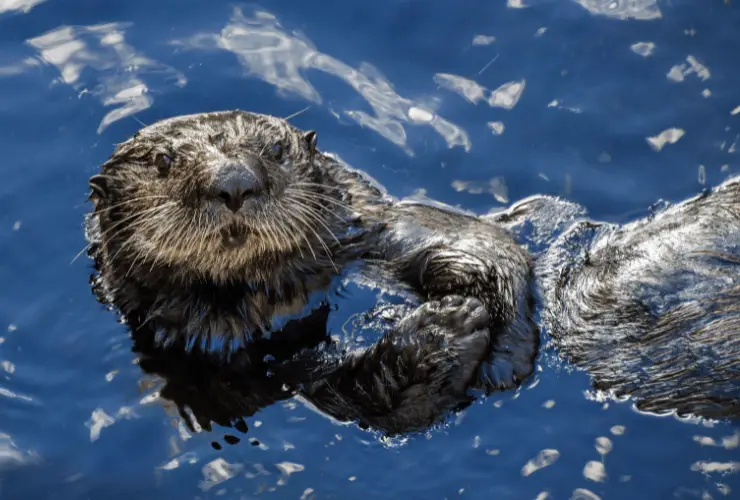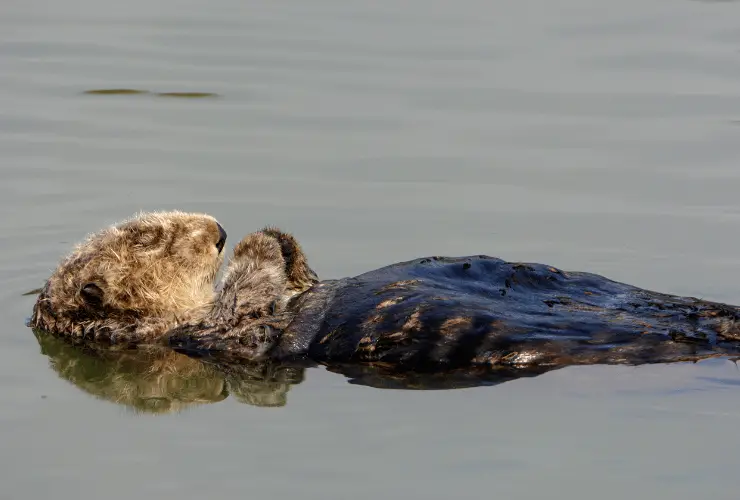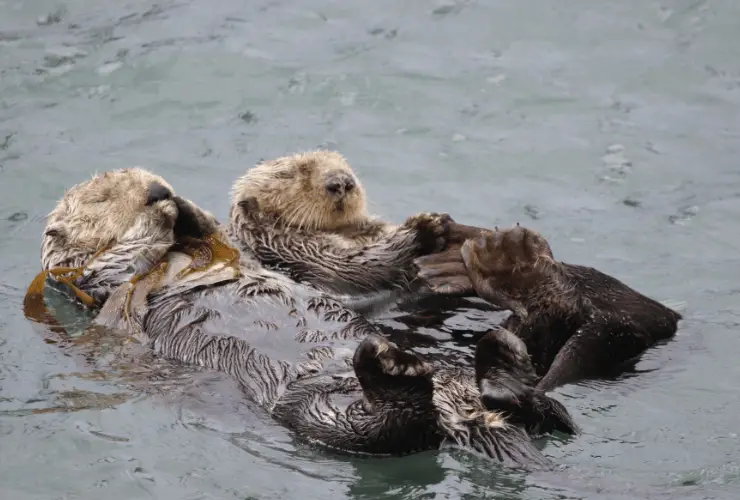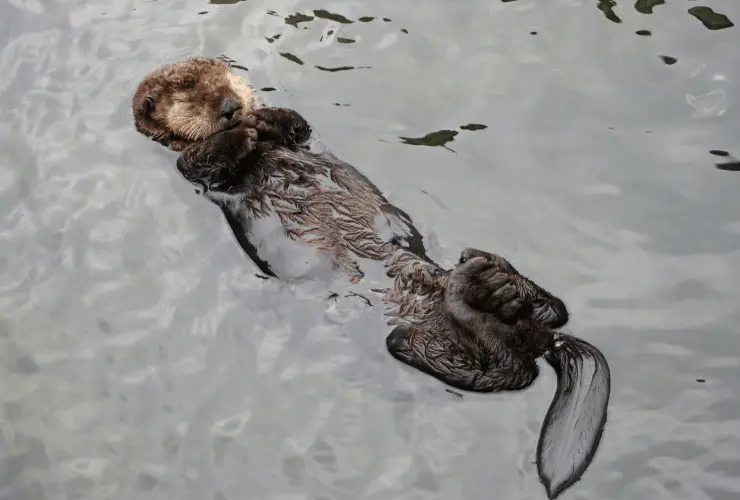Sea otters do sleep. They can sleep at any time, be it day or night. Typically, you will find them sleeping in groups, called rafts, floating on their backs on the ocean surface. They often wrap themselves in kelp or hold hands. This prevents them from drifting apart due to ocean currents while they are asleep.
Have you ever wondered how sea otters sleep in the ocean amidst the waves and currents? Their unique sleep behavior is a remarkable adaptation to their marine lifestyle. Floating on their backs in groups and holding hands to avoid drifting apart, otters turn the challenge of sleeping in water into a charming spectacle.
Read this blog to learn about the sleep habits of sea otters. We’ll explore how these unique creatures have adapted to thrive in their oceanic environment.
Do Sea Otters Sleep at Night or During the Day?
According to a study published in the Aquatic Mammals Journal, sea otters display peak periods of activity at dawn, midday, and dusk. But their resting, feeding, grooming, and traveling occur throughout the day and night.
This means they sleep or rest intermittently throughout the 24-hour period, with no distinct preference for sleeping during either daytime or nighttime.

This pattern of sleeping throughout the day and night is not uncommon among marine mammals. They have to balance the need for rest with the need to frequently surface for air, avoid predators, and seek food.
This flexibility in their rest-activity cycles allows them to adapt to changing environmental conditions and optimize their foraging and social interactions.
A study in The Journal of Wildlife Management focused on California’s sea otters and pointed out that sea otters in this region showed several bouts of activity and rested both day and night. These activity-rest cycles, however, varied among individuals. Factors like sex, age, reproductive status, and environmental conditions influenced their activities.
How Do Sea Otters Sleep?
Sea otters are renowned for their distinctive sleeping habits, which are perfectly adapted to their aquatic surroundings. They habitually doze off while floating on their backs on the water’s surface.
Moreover, sea otters wrap themselves in kelp, a type of seaweed that grows from the seafloor to the surface. It helps to create a natural anchor to prevent them from drifting due to ocean currents. This behavior ensures they remain in their preferred territories even while sleeping.
Some sea otters also prefer to sleep in rafts. A raft of otters can contain from two to hundreds of otters, linked together to help them stay in the same area. Mostly male sea otters come to sleep in rafts. However, a combination of females and their pups are also found sleeping in rafts.
Did you know? Sea otters can sleep in both non-REM and REM sleep stages. While they often close their eyes during non-REM sleep, they have been observed to move their flippers or twitch their whiskers during REM sleep, which in many mammals is associated with dreaming. ~ Source
Where Do Sea Otters Sleep?

Sea otters typically sleep in the water, floating on the surface. Their natural habitats include the coastal waters of the Northern Pacific Ocean, extending from Japan to Alaska. They also inhabit North America’s western coast and Mexico’s Baja California.
Do Sea Otters Sleep on Land?
In some cases, sea otters have been observed to sleep on land – though this is less common. When they sleep on land, it’s typically in areas with easy access to the water, like rocky coastlines or beaches.
How Long Do Sea Otters Sleep?
Sea otters generally spend a significant portion of their day resting or sleeping. On average, they sleep or rest about 9 to 11 hours daily, typically in bouts of several hours at a time.
Do Sea Otters Hold Hands When They Sleep?

One of the reasons why these animals are very popular in today’s day and age is that they hold hands when they sleep. The sight of otters holding hands is not only endearing, but it’s also a key survival strategy.
Sea otters tend to entangle themselves with one another, so they don’t drift away. Since the sea is always moving, these creatures intertwine with other sea otters, so they don’t swirl away. This is also the only reason why they hold hands.
Why Do Sea Otters Sleep on Their Backs?
Earlier, we mentioned many times that sea otters sleep on their backs. So, you might be wondering why sea otters choose to sleep in this position and don’t sleep in any other position other than on their backs.
Sea otters sleep on their backs as an adaptation to their aquatic environment. Being on their backs allows them to float on the water’s surface, thus conserving energy that would otherwise be used in swimming or staying upright.
This sleeping position also keeps their sensitive facial areas, like their nose and eyes, out of the water, which can be especially important in colder climates.

Moreover, their unique fur, which is the densest of any animal with up to 1 million hairs per square inch, traps a layer of air against their bodies, providing both insulation from the cold water and extra buoyancy to aid in floating.
Did you know? Sea otters often place their paws over their chests, trapping an additional pocket of warm air for insulation and flotation.
FAQs
Do sea otters cover their eyes to sleep?
Yes, sea otters frequently use their paws to cover their eyes during daylight hours, aiding them in sleeping.
How Long Can Otters Stay Underwater?
Sea otters can only stay underwater for about 5 minutes. They generally only go underwater to look for certain prey.
Do Sea Otters Sleep Underwater?
Sea otters sleep for long durations. On the other hand, they can only stay underwater for a few minutes.
So, in a nutshell, sea otters cannot sleep underwater because they do not have the physical ability to even stay underwater for prolonged periods. Hence, they sleep on top of the water’s surface instead of under it.
Conclusion
Indeed, sea otters do sleep. Like many other animals, otters require sleep to rest and recharge their bodies. However, sea otters have unique sleeping habits compared to some other mammals.
Sea otters sleep on land, sometimes on the ground or in rafts. They sleep on their backs while holding onto each other or seaweed, so they don’t drift away. They are cathemeral animals that perform their tasks during the 24-hour cycle.



2 thoughts on “Do Sea Otters Sleep at Night or During the Day?”